| Pages:
1
2
3
4
5
..
8 |
bfesser
Resident Wikipedian
    
Posts: 2114
Registered: 29-1-2008
Member Is Offline
Mood: No Mood
|
|
Again, the first one looks like chalcedony. The ones in the sixth photo appear to be river-worn granite <a
href="https://en.wikipedia.org/wiki/Particle_size_(grain_size)" target="_blank">cobbles and pebbles</a> <img src="../scipics/_wiki.png"
/>. Are strong magnets attracted to any of the others?
If it's alright, I'd like to keep this topic going as a sort of 'geology pretty pictures' thread. Here is a composite photo I made of the bend in the
St. Croix river through <a href="https://en.wikipedia.org/wiki/Interstate_Park" target="_blank">Interstate Park</a> <img
src="../scipics/_wiki.png" />—the view is from 'Angle Rock' on the inside (MN) of the sharp bend caused by the river eroding down through
a fault in the basalt (<a href="http://aerialgeologist.blogspot.com/2013_07_01_archive.html" target="_blank">ref.</a> <img
src="../scipics/_ext.png" /> : :
<a href="http://www.flickr.com/photos/35937732@N02/11988098314/" title="St. Croix River, Interstate Park, MN by bfesser, on Flickr"
target="_blank"><img src="http://farm6.staticflickr.com/5530/11988098314_a41ff2a934_c.jpg" width="800" height="176" alt="St. Croix River,
Interstate Park, MN"></a> <img src="../scipics/_ext.png" valign="top" />
(Yes, I'm aware of the slight compositing error in the trees near the right of the photo. I was unable to correct it.)
Attachment: interstate_geology.pdf (716kB)
This file has been downloaded 1262 times
[Edited on 30.1.14 by bfesser]
|
|
|
blargish
Hazard to Others
  
Posts: 166
Registered: 25-9-2013
Location: Canada
Member Is Offline
Mood: Mode Push
|
|
Quote: Originally posted by Morgan  |
Some other rocks, last of the pile. And so concludes this collection of misfit rocks, rocks that weren't showy enough to be indoors. Individually each
one didn't have much appeal to me, but now that I look at them collectively, they do.
Thanks again to all for all the interesting comments.
[Edited on 30-1-2014 by Morgan] |
In the second picture, those big shiny plates look like muscovite. Is that some sort of muscovite schist?
BLaRgISH
|
|
|
Morgan
International Hazard
    
Posts: 1694
Registered: 28-12-2010
Member Is Offline
Mood: No Mood
|
|
It could be muscovite, I'm not one to ask as I know very little. I could say it looks like mica and that's about it.
bfessor some time ago I put some little square neodymium magnets on the rocks to test them and I was surprised how many at least stuck well enough to
hold on without falling off. That one on the end in the last post I made is of course highly attracted to a magnet.
By all means feel free to kept the thread going. I wish I could find new rocks but living along the gulf coast there's a lot of sand and clay. I was
watch PBS though and not too far from here they mined a small area for a bit of iron ore containing rocks.
When I lived here long ago as a boy there were these cliffs that had really pretty colored clays, I remember digging out muddy purples, yellow, and
red all right next to each to each other, like melted plastic. It was soft and malleable. I also liked finding the lighter pumice rocks on the
railroad tracks, we'd put them in the water to see which ones float.
Here's some ringing rocks you might be able to whittle a unique tuning fork out of.
Ringing Rocks Park Pottstown, Pennsylvania
http://www.youtube.com/watch?v=NBfrLoBpsIQ
I like the sound sand can make. There're several good booming sand clips.
The song of the dunes
http://www.youtube.com/watch?v=4yFaMsUawi4
Booming Sands
http://www.youtube.com/watch?v=0XF6kGDLcVE
[Edited on 30-1-2014 by Morgan]
|
|
|
Pathos
Harmless

Posts: 14
Registered: 16-8-2012
Location: Top shelf, over to the Left
Member Is Offline
Mood: Quixotic
|
|
| Quote: | | The amber looking rock is too heavy to be amber but the crinkle effect and color does look like it. |
Am still thinkin' its amber...A chunk of natural amber that size wouldn't feel too much different from a rock of the same size. It can be surprisingly
heavy. The appearance is spot on too: it usually looks kinda like lava, forming globs & puddles as it flows...but also gets the crinkled effect
from all the pine needles and other crud that it encounters from being so damned sticky all the time. hehhe...
I opened the picture in a pic editor and tried to mess around with the brightness/contrast/colors/etc a little bit, attached below. May have gone a
smidge too far into the 'reds'. Whatever the case, its a very cool piece. I'd love to see more pics from different angles at some point - am
interested in the slightly darker 'bulbs' on right&left corners, and maybe back corner too? It's too hard to say for sure from the one pic...
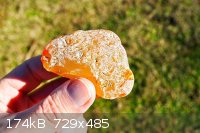 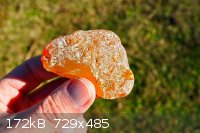
My first thought was mica or vermiculite for the flaky stuff too. It does look pretty identical to muscovite I've seen before but the
placement/occurence of it in that speciment are way more consistent with mica I've seen (in my very limited experience).
I'm glad you expanded the thread bfesser! Now I have excuse to dig out all sorts of goodies! I've got a few Aquamarines with cool looking muscovite all over them that would pertain to this particular discussion.
Those will be first, & then maybe a ton of natural pyrite samples I've got in a cigar box somewhere a bit later. I've got a few Aquamarines with cool looking muscovite all over them that would pertain to this particular discussion.
Those will be first, & then maybe a ton of natural pyrite samples I've got in a cigar box somewhere a bit later.
"Hoc natura est insitum, ut quem timueris, hunc semper oderis"
~
"It is an innate thing for people to always hate what they've learned to fear"
-Roman Proverb-
|
|
|
blargish
Hazard to Others
  
Posts: 166
Registered: 25-9-2013
Location: Canada
Member Is Offline
Mood: Mode Push
|
|
Quote: Originally posted by Pathos  |
My first thought was mica or vermiculite for the flaky stuff too. It does look pretty identical to muscovite I've seen before but the
placement/occurence of it in that speciment are way more consistent with mica I've seen (in my very limited experience).
|
I always thought that muscovite was a type of mica?
I look forward to seeing the pics of your aquamarines!
BLaRgISH
|
|
|
Pathos
Harmless

Posts: 14
Registered: 16-8-2012
Location: Top shelf, over to the Left
Member Is Offline
Mood: Quixotic
|
|
Yeah I suppose you're right...I guess I've always thought of 'mica' as being sort of a loosely defined term for any rocks/minerals that behave like,
well, the other 'micas'.
Anyways I owe you a 'Thanks!' since your comment spurred me to actually look it up and learn something! From Wikipedia:
| Quote: |
---Trioctahedral micas
--Common micas:
Biotite
Lepidolite
Muscovite
Phlogopite
Zinnwaldite
Brittle micas:
- Clintonite
---Interlayer deficient micas
Very fine-grained micas, which typically show more variation in ion and water content, are informally termed "clay micas". They include:
- Hydro-muscovite with H3O+ along with K in the X site;
- Illite with a K deficiency in the X site and correspondingly more - Si in the Z site;
- Phengite with Mg or Fe2+ substituting for Al in the Y site and a corresponding increase in Si in the Z site. |
Regarding the aquamarines, I just realized that I no longer have a real/quality camera here. Gonna have to choose between just a couple megapixels
from my phone or couple megapixels from my kindle...No big deal though should still be able to see some acceptable level of detail..
"Hoc natura est insitum, ut quem timueris, hunc semper oderis"
~
"It is an innate thing for people to always hate what they've learned to fear"
-Roman Proverb-
|
|
|
Morgan
International Hazard
    
Posts: 1694
Registered: 28-12-2010
Member Is Offline
Mood: No Mood
|
|
Pathos I will fiddle with the amber colored rock and take another photo this weekend. What about that dirty white crinkled rock I posted, would a
white tree sap mineralize or if anyone has a guess?
I came across these amber tidbits if anyone can add to it or point out any flaws.
http://www.rockhounds.com/rockshop/trueamber.shtml
I'll post some other kinds of old rocks I found, some that I forgot about, mostly ones that I was seeing if magnets would stick to them.
|
|
|
bfesser
Resident Wikipedian
    
Posts: 2114
Registered: 29-1-2008
Member Is Offline
Mood: No Mood
|
|
<em>Disclaimer: you simply can't identify a mineral from a photo alone. That being said...</em>
Morgan, <a href="files.php?pid=317177&aid=29199">this one</a> looks like it could be chalcedony. Rather than
continuing to post photos and go by visual evidence alone, perhaps you should look into learning more about <a
href="https://en.wikipedia.org/wiki/List_of_mineral_tests" target="_blank">mineral properties and identification tests</a> <img
src="../scipics/_wiki.png" />—it would help to make this a more scientific and valuable thread. It's unclear which <a
href="viewthread.php?tid=28664&page=2#pid316792">rocks you're referring to</a>; regardless, neither of them are <a
href="https://en.wikipedia.org/wiki/Banded_iron_formation" target="_blank">banded iron formation</a> <img src="../scipics/_wiki.png"
/>. I've collected two specimens of banded iron formation from two different locations in MN (see photos below). Morgan's
specimens look more like <a href="viewthread.php?tid=25943#pid297416">iron-stained sandstone</a>, to me.
<table><tr><td><a href="http://www.flickr.com/photos/35937732@N02/12227172176/" title="Banded Iron Formation by bfesser, on
Flickr" target="_blank"><img src="http://farm3.staticflickr.com/2818/12227172176_dbcd968718_m.jpg" width="240" height="180" alt="Banded Iron
Formation"></a></td><td><a href="http://www.flickr.com/photos/35937732@N02/12227261286/" title="Banded Iron Formation by
bfesser, on Flickr" target="_blank"><img src="http://farm4.staticflickr.com/3819/12227261286_43b49af723_m.jpg" width="240" height="180"
alt="Banded Iron Formation"></a></td><td><a href="http://www.flickr.com/photos/35937732@N02/12226865863/" title="Banded Iron
Formation by bfesser, on Flickr" target="_blank"><img src="http://farm6.staticflickr.com/5478/12226865863_28fb00266c_m.jpg" width="240"
height="180" alt="Banded Iron Formation"></a></td></tr><tr><td align="center">Banded Fe Formation<br
/>(Specimen 1)</td><td align="center">with magnet<br />(Specimen 1)</td><td align="center">banding detail<br
/>(Specimen 1)</td></tr></table>
<table><tr><td><a href="http://www.flickr.com/photos/35937732@N02/12226674583/" title="Banded Iron Formation by bfesser, on
Flickr" target="_blank"><img src="http://farm6.staticflickr.com/5481/12226674583_e121371707_m.jpg" width="240" height="180" alt="Banded Iron
Formation"></a></td><td><a href="http://www.flickr.com/photos/35937732@N02/12227070916/" title="Banded Iron Formation by
bfesser, on Flickr" target="_blank"><img src="http://farm4.staticflickr.com/3771/12227070916_58748d153e_m.jpg" width="240" height="180"
alt="Banded Iron Formation"></a></td><td><a href="http://www.flickr.com/photos/35937732@N02/12226882644/" title="Banded Iron
Formation by bfesser, on Flickr" target="_blank"><img src="http://farm4.staticflickr.com/3704/12226882644_38738f51b6_m.jpg" width="240"
height="180" alt="Banded Iron Formation"></a></td></tr><tr><td align="center">Banded Fe Formation<br
/>(Specimen 2)</td><td align="center">with magnet<br />(Specimen 2)</td><td align="center">vein detail<br
/>(Specimen 2)</td></tr></table> Quote: Originally posted by bfesser  | | I tried taking photos of some of my mica schist specimens a few days ago, but my camera battery died before I got up to the good specimens from the
<a href="http://www.mindat.org/loc-22519.html" target="_blank">Black Hills, SD</a> <img src="../scipics/_ext.png" />.
|
I recharged the batteries and took these photos today—not the outcrop:
<table><tr><td><a href="http://www.flickr.com/photos/35937732@N02/12226644733/" title="Almandine Staurolite Schist by bfesser, on
Flickr" target="_blank"><img src="http://farm4.staticflickr.com/3800/12226644733_51e5825315_m.jpg" width="240" height="180" alt="Almandine
Staurolite Schist"></a></td><td><a href="http://www.flickr.com/photos/35937732@N02/12226435345/" title="Staurolite Almandine
Schist by bfesser, on Flickr" target="_blank"><img src="http://farm8.staticflickr.com/7332/12226435345_b7e9d3c6ff_m.jpg" width="240"
height="180" alt="Staurolite Almandine Schist"></a></td><td><a href="http://www.flickr.com/photos/35937732@N02/12226606183/"
title="Staurolite Almandine Schist by bfesser, on Flickr" target="_blank"><img
src="http://farm3.staticflickr.com/2888/12226606183_eef61e915d_m.jpg" width="240" height="180" alt="Staurolite Almandine
Schist"></a></td></tr><tr><td align="center">Almandine Staurolite Schist</td><td
align="center">Staurolite Almandine Schist</td><td align="center">Staurolite Almandine Schist</td></tr></table>
<table><tr><td><a href="http://www.flickr.com/photos/35937732@N02/12227284236/" title="Almandine Mica Schist by bfesser, on
Flickr" target="_blank"><img src="http://farm4.staticflickr.com/3766/12227284236_c4a7ea363d_m.jpg" width="240" height="180" alt="Almandine Mica
Schist"></a></td><td><a href="http://www.flickr.com/photos/35937732@N02/12226641115/" title="Phyllite by bfesser, on Flickr"
target="_blank"><img src="http://farm3.staticflickr.com/2854/12226641115_bb53b349ec_m.jpg" width="240" height="180"
alt="Phyllite"></a></td><td><a href="http://www.flickr.com/photos/35937732@N02/12226754613/" title="Schorl Muscovite Schist by
bfesser, on Flickr" target="_blank"><img src="http://farm6.staticflickr.com/5524/12226754613_966b795f51_m.jpg" width="240" height="180"
alt="Schorl Muscovite Schist"></a></td></tr><tr><td align="center">Almandine Mica Schist</td><td
align="center">Phyllite</td><td align="center">Schorl Muscovite Schist</td></tr></table>
<table><tr><td><a href="http://www.flickr.com/photos/35937732@N02/12226528335/" title="Almandine Schist by bfesser, on Flickr"
target="_blank"><img src="http://farm3.staticflickr.com/2831/12226528335_57316294e1_m.jpg" width="240" height="180" alt="Almandine
Schist"></a></td><td><a href="http://www.flickr.com/photos/35937732@N02/12226697643/" title="Mica Schist by bfesser, on
Flickr" target="_blank"><img src="http://farm8.staticflickr.com/7348/12226697643_708f9b42ed_m.jpg" width="240" height="180" alt="Mica
Schist"></a></td><td><a href="http://www.flickr.com/photos/35937732@N02/11989791613/" title="DSCN0232 by bfesser, on Flickr"
target="_blank"><img src="http://farm3.staticflickr.com/2832/11989791613_0d7e96aa57_m.jpg" width="240" height="180"
alt="DSCN0232"></a></td></tr><tr><td align="center">Almandine Mica Schist</td><td align="center">Mica
Schist</td><td align="center">Schist?</td></tr></table> Quote: Originally posted by chemrox  | | I just started looking at these. The first were the mineral fluorite... good examples too... typical colors are white, violet-purple and green. The
purple kind is easily confused with amethyst until you scratch it. |
I agree that they're a bit tricky to
distinguish by appearance. A simple scratch test would allow <a href="https://en.wikipedia.org/wiki/Mohs_scale_of_mineral_hardness"
target="_blank">relative hardness</a> <img src="../scipics/_wiki.png" /> of <a
href="viewthread.php?tid=28664&page=2#pid316786">these specimens</a> to be determined. <a href="http://www.mindat.org/min-1576.html"
target="_blank">Fluorite</a> <img src="../scipics/_ext.png" /> has a hardness of 4, while <a
href="http://www.mindat.org/min-3337.html" target="_blank">quartz</a> <img src="../scipics/_ext.png" /> has a hardness of 7. Failing
to scratch plate glass (5.5) would rule out quartz.
Finally, since the subject of mica has been brought up:
<table><tr><td><a href="http://www.flickr.com/photos/35937732@N02/12226843263/" title="Biotite & Muscovite by bfesser, on
Flickr" target="_blank"><img src="http://farm4.staticflickr.com/3732/12226843263_232d4b69d8_m.jpg" width="180" height="240" alt="Biotite
& Muscovite"></a></td><td><a href="http://www.flickr.com/photos/35937732@N02/12226743743/" title="Muscovite by
bfesser, on Flickr" target="_blank"><img src="http://farm3.staticflickr.com/2844/12226743743_5b32cefdc5_m.jpg" width="240" height="180"
alt="Muscovite"></a></td></tr><tr><td align="center">Biotite & Muscovite</td><td
align="center">Muscovite</td></tr></table>
[Edited on 31.1.14 by bfesser]
|
|
|
Pathos
Harmless

Posts: 14
Registered: 16-8-2012
Location: Top shelf, over to the Left
Member Is Offline
Mood: Quixotic
|
|
| Quote: | Pathos I will fiddle with the amber colored rock and take another photo this weekend. What about that dirty white crinkled rock I posted, would a
white tree sap mineralize or if anyone has a guess?
I came across these amber tidbits if anyone can add to it or point out any flaws.
http://www.rockhounds.com/rockshop/trueamber.shtml |
Coolio. Try to get a shot of each tip or corner if possible! We found a bunch of those white-crinkled rocks too in our searches, & my friend kept
a few of the cooler ones, but I can't remember if we ever determined what it was or not(much less what the name was if we did). I might be able to
track him down and grab a piece for analysis though.
That's a very helpful Amber site! Their specimens are supeeerrr cleaned up - no doubt ball-milled & polished too - but trust me every natural
piece I've seen looks almost exactly like yours. Regardless a real test is the only way to know. The Density and Acetone tests would be a breeze to
do, and then you'd know for sure.
bfesser: WOW nice pics of some very nice specimens! Those sheets of muscovite are veerrry neat indeed. I couldn't zoom all the way in on the Almandine
Mica Schist pics, but the general appearance reminds me of a few chunks I collected because they had what looked like a black pyrite all over them. Is
that how you would describe it? I'll post some pics of what I'm talking about (along with the aquamarines and some fluorites) when I get home very
soon here.
chemrox was right on the money though, the green and clear/cloudy white/purple ones are all fluorite. My buddy and I tested the theory back when we
collected our samples, and they were identical to morgan's pics. REALLY wish I still had some pics of them! GRR!
pics coming soon!
"Hoc natura est insitum, ut quem timueris, hunc semper oderis"
~
"It is an innate thing for people to always hate what they've learned to fear"
-Roman Proverb-
|
|
|
Morgan
International Hazard
    
Posts: 1694
Registered: 28-12-2010
Member Is Offline
Mood: No Mood
|
|
The amber colored crinkle rock is about as hard as quartz I would say and certainly not a 2-3. I heated an edge and it changed to a darker orange and
a tiny flaky shard popped off. I hit the rock with the wire wheel side of my grinder and then the grinding stone side and it's hard. Still I don't
have a name for it.
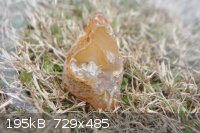 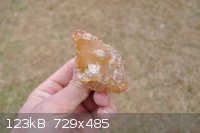 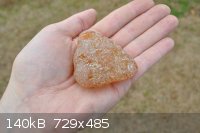 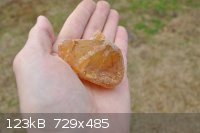
[Edited on 2-2-2014 by Morgan]
|
|
|
Morgan
International Hazard
    
Posts: 1694
Registered: 28-12-2010
Member Is Offline
Mood: No Mood
|
|
bfesser here's that one rock I tried to magnify for you with meager results. With my eyes it seems like one or two flecks are red but the camera
doesn't really show it.
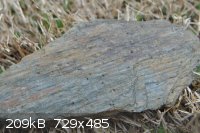 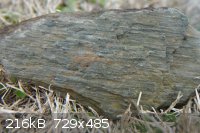
|
|
|
Morgan
International Hazard
    
Posts: 1694
Registered: 28-12-2010
Member Is Offline
Mood: No Mood
|
|
This rock is really glittery in strong sunlight and it leaves glitter on your fingers too.
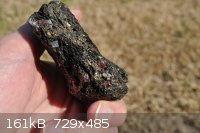 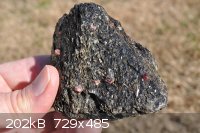 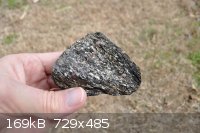 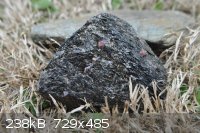 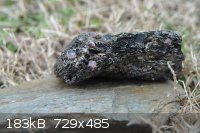
|
|
|
bfesser
Resident Wikipedian
    
Posts: 2114
Registered: 29-1-2008
Member Is Offline
Mood: No Mood
|
|
<a href="http://en.wikipedia.org/wiki/Agate"
target="_blank">Agate</a> <img src="../scipics/_wiki.png" />
2nd specimen: I'm sticking by my tentative identification (phyllite).
3rd specimen: <a href="http://en.wikipedia.org/wiki/Biotite" target="_blank">Biotite</a> <img src="../scipics/_wiki.png" /> schist
with garnet.
[Edited on 2.2.14 by bfesser]
|
|
|
Morgan
International Hazard
    
Posts: 1694
Registered: 28-12-2010
Member Is Offline
Mood: No Mood
|
|
Neodymium magnets will stick to this, better in some spots if I recall. It has a more glittery appearance and slightly greener if viewed directly
instead of the camera.
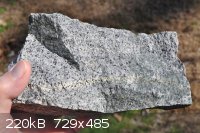 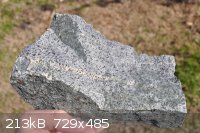
|
|
|
Morgan
International Hazard
    
Posts: 1694
Registered: 28-12-2010
Member Is Offline
Mood: No Mood
|
|
I was going to say agate but it would have been a guess. I vaguely remember some agates on the coast of Oregon, rocks along the seashore.
Here's something relavent perhaps.
http://people.oregonstate.edu/~wilsolau/agates.html
http://oregonagateguide.blogspot.com/2013/05/rough-carnelian...
<!-- bfesser_edit_tag -->[<a href="u2u.php?action=send&username=bfesser">bfesser</a>: removed
unnecessary quote(s)]
[Edited on 2.2.14 by bfesser]
|
|
|
Morgan
International Hazard
    
Posts: 1694
Registered: 28-12-2010
Member Is Offline
Mood: No Mood
|
|
I think I found the source of that piece of white crinkle rock but not the name.
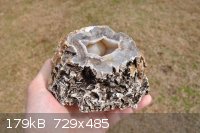 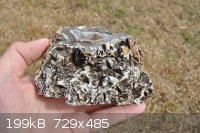 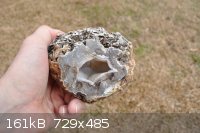 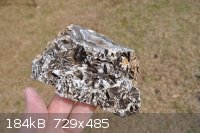
|
|
|
Morgan
International Hazard
    
Posts: 1694
Registered: 28-12-2010
Member Is Offline
Mood: No Mood
|
|
I was wondering what the green is?
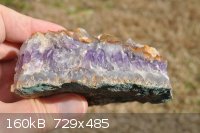 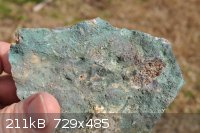 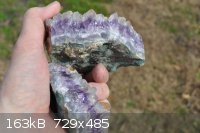
|
|
|
blargish
Hazard to Others
  
Posts: 166
Registered: 25-9-2013
Location: Canada
Member Is Offline
Mood: Mode Push
|
|
Is it possible that the blue is turquoise? I've seen rough turquoise samples that look similar...
The "crinkle rock" above looks to be some sort of chalcedony (agate?) with a vug of quartz drusy.
Also, that's a nice biotite garnet schist specimen you got
[Edited on 2-2-2014 by blargish]
BLaRgISH
|
|
|
Morgan
International Hazard
    
Posts: 1694
Registered: 28-12-2010
Member Is Offline
Mood: No Mood
|
|
blargish I will see what I can do to figure out what that turquoise suspect is. Oddly, I thought the dirt on the crinkle rock kind of enhanced the
quality of the crinkles.
|
|
|
Morgan
International Hazard
    
Posts: 1694
Registered: 28-12-2010
Member Is Offline
Mood: No Mood
|
|
This one reminds me of fine clay sort of.
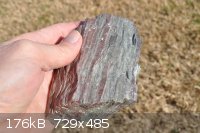 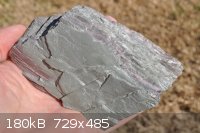 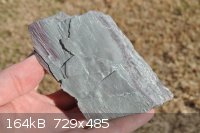
|
|
|
bfesser
Resident Wikipedian
    
Posts: 2114
Registered: 29-1-2008
Member Is Offline
Mood: No Mood
|
|
<strong>Morgan;</strong><ol><li>Please perform tests on the specimen. As I've repeatedly pointed out, you can't reliably
identify rocks & minerals from photos alone.</li><li>Quartz (amethyst & citrine) with <a
href="http://en.wikipedia.org/wiki/Malachite" target="_blank">malachite</a> <img src="../scipics/_wiki.png"
/></li><li><a href="http://en.wikipedia.org/wiki/Slate" target="_blank">Slate</a> <img src="../scipics/_wiki.png"
/></li></ol><hr width="80%" />
How about some <a href="http://en.wikipedia.org/wiki/Structural_geology" target="_blank">Structural Geology</a> <img
src="../scipics/_wiki.png" /> and <a href="http://en.wikipedia.org/wiki/Geomorphology" target="_blank">Geomorphology</a> <img
src="../scipics/_wiki.png" />?
<table><tr><td><a href="http://www.flickr.com/photos/35937732@N02/12021788934/" title="Hogback by bfesser, on Flickr"
target="_blank"><img src="http://farm8.staticflickr.com/7385/12021788934_99bf6c0e05_m.jpg" width="240" height="180"
alt="Hogback"></a></td><td><a href="http://www.flickr.com/photos/35937732@N02/12022096523/" title="Shell Creek Monocline by
bfesser, on Flickr" target="_blank"><img src="http://farm4.staticflickr.com/3773/12022096523_c6fd7a7a78_m.jpg" width="240" height="180"
alt="Shell Creek Monocline"></a></td><td><a href="http://www.flickr.com/photos/35937732@N02/12021468725/" title="Amsden
Formation Syncline by bfesser, on Flickr" target="_blank"><img src="http://farm4.staticflickr.com/3680/12021468725_3d9d4f1ed0_m.jpg" width="240"
height="180" alt="Amsden Formation Syncline"></a></td></tr><tr><td align="center"><a
href="http://en.wikipedia.org/wiki/Hogback_(geology)" target="_blank">Hogback</a> <img src="../scipics/_wiki.png" /></td><td
align="center"><a href="http://en.wikipedia.org/wiki/Monocline" target="_blank">Monocline</a> <img src="../scipics/_wiki.png"
/></td><td align="center"><a href="http://en.wikipedia.org/wiki/Syncline" target="_blank">Syncline</a> <img
src="../scipics/_wiki.png" /> (accompanying fault)</td></tr></table>
[Edited on 2.2.14 by bfesser]
|
|
|
Morgan
International Hazard
    
Posts: 1694
Registered: 28-12-2010
Member Is Offline
Mood: No Mood
|
|
I split some black obsidian . The pieces almost look like black tar, how smooth they are when fractured.
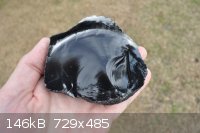 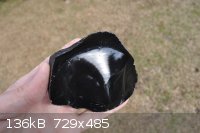 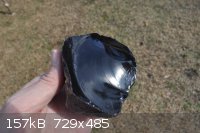
|
|
|
Morgan
International Hazard
    
Posts: 1694
Registered: 28-12-2010
Member Is Offline
Mood: No Mood
|
|
I might try some colorful green fire flame test with the copper carbonate from one of those rocks bfesser, just to see what kind vividness I can get
using methanol. Thanks for identifying the specimen. I remember reading somewhere, perhaps National Geographic or something about Russia and
malachite, that the dust from working the works of art an occupational hazard, back when they were made.
Here's a colorful corrosion effect.
http://en.wikipedia.org/wiki/File:Verdigris.JPG
"The flame was actually green and I think its from the cooper because I did not add any boric acid."
http://www.youtube.com/watch?v=GIstWmvSkbA
[Edited on 2-2-2014 by Morgan]
|
|
|
Morgan
International Hazard
    
Posts: 1694
Registered: 28-12-2010
Member Is Offline
Mood: No Mood
|
|
Here's a quartz-like rock which is slightly translucent on the outer surface that seems kind of geode or vug in nature. It's really heavy so probably
not hollow. Maybe it would be more telling if it were cracked or sawed open.
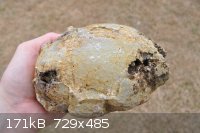 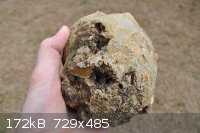 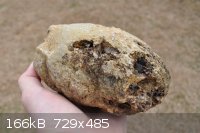
|
|
|
Pathos
Harmless

Posts: 14
Registered: 16-8-2012
Location: Top shelf, over to the Left
Member Is Offline
Mood: Quixotic
|
|
Ah, I see the orange one ended up being agate. The extra pics/angles were definitely helpful. Latest crinkly pics are rad - nice rock! Same goes for
that biotite garnet schist specimen. Be careful with that one if its very soft because those garnets could just fall out & would be tragic to lose
them.
These are a couple days later than I had originally anticipated - but here's those Aquamarine w/ Muscovite pics I mentioned previously, along with a
couple Fluorites just for fun 
Aquamarines:
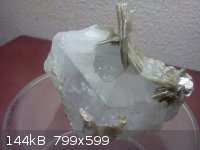 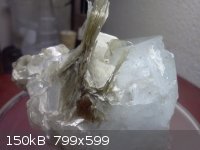 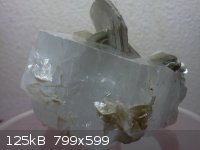 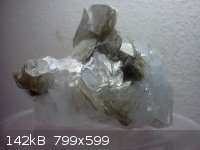 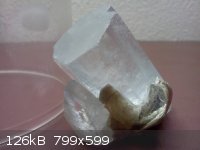 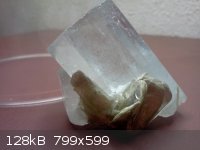 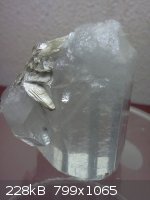
Fluorites:
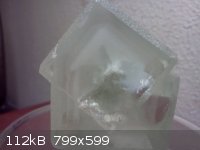 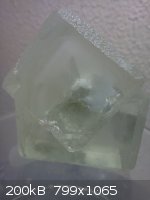 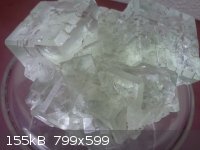
Sorry about the lighting  ...I was pretty stoked to see how well the "phantoms" and
bevelled edges showed up in the first fluorite pic. That's probably one of my fav crystals. It was *flawless* the day I got it - and later that same
day I was doing some homework and put it on the base of my lamp so I could get a better look at it. Needless to say I somehow knocked it off, and it
fell a distance of 1 inch onto the desk below. That's what caused the noticeable 'ding' just to the left of the bottom-point in the diamond-oriented
cube...so weak... ...I was pretty stoked to see how well the "phantoms" and
bevelled edges showed up in the first fluorite pic. That's probably one of my fav crystals. It was *flawless* the day I got it - and later that same
day I was doing some homework and put it on the base of my lamp so I could get a better look at it. Needless to say I somehow knocked it off, and it
fell a distance of 1 inch onto the desk below. That's what caused the noticeable 'ding' just to the left of the bottom-point in the diamond-oriented
cube...so weak...
[Edited on 2-3-2014 by Pathos]
"Hoc natura est insitum, ut quem timueris, hunc semper oderis"
~
"It is an innate thing for people to always hate what they've learned to fear"
-Roman Proverb-
|
|
|
| Pages:
1
2
3
4
5
..
8 |